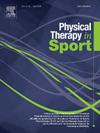股骨髋臼撞击综合征患者的跑步生物力学:性别差异的横断面分析及其与患者报告的结果测量的关系
IF 2.2
3区 医学
Q1 REHABILITATION
引用次数: 0
摘要
目的(i)调查女性和男性股骨髋臼撞击综合征患者下肢跑步生物力学是否存在差异,以及(ii)探讨下肢跑步生物力学与症状严重程度和运动相关问题之间是否存在性别特异性关系。SettingGait实验室。20名女性和22名男性参加了一项由物理治疗师主导的股骨髋臼撞击综合征治疗的临床试验。主要结果测量:在站立阶段,髋关节、膝关节和踝关节的运动学和动力学(从三维生物力学数据计算)使用统计参数映射进行比较。国际髋关节结局工具-33和哥本哈根髋关节和腹股沟结局评分量化了髋关节相关症状的严重程度和运动相关问题。结果女性髋内收角度比男性大(34% ~ 44%,p = 0.045)。在动力学方面,女性表现出较大的髋关节外伸力矩(77%-100%,p = 0.001),较小的膝关节外伸力矩(80%-100%,p = 0.007)和较小的踝关节背屈力矩(26%-67%,p <;0.001)。较差的运动相关担忧与女性髋部最大伸角(0.18,95%CI 0.05,0.31)和较小的髋部弯曲力矩冲量(0.14∗10-2,95%CI 0.02∗10-2,0.25∗10-2)以及较小的男性髋部外旋力矩冲量(0.06∗10-2,95%CI 0.01∗10-2,0.11∗10-2)相关。结论FAI综合征的女性和男性下肢跑步生物力学存在差异,症状严重程度和跑步生物力学之间存在性别依赖性,值得在未来的分析中考虑。本文章由计算机程序翻译,如有差异,请以英文原文为准。
Running biomechanics in people with femoroacetabular impingement syndrome: A cross-sectional analysis of sex differences and relationships with patient reported outcome measures
Objectives
(i) Investigate if lower-limb running biomechanics differ between women and men with femoroacetabular impingement syndrome, and (ii) explore whether sex-specific relationships between lower-limb running biomechanics and symptom severity and sport-related concerns exist.
Design
Cross-sectional.
Setting
Gait laboratory.
Participants
Twenty women and 22 men enrolled in a clinical trial of physiotherapist-led treatments for femoroacetabular impingement syndrome.
Main outcome measures
Kinematics and kinetics of hip, knee, and ankle joints during the stance phase (calculated from three-dimensional biomechanics data) were compared using statistical parametric mapping. The International Hip Outcome Tool-33 and Copenhagen Hip and Groin Outcomes Score quantified hip-related symptom severity and sport-related concerns.
Results
Women had larger hip adduction angles (34%–44% of stance,p = 0.045) than men. For kinetics, women displayed larger external hip extension moments (77%–100%,p = 0.001), smaller knee extension moments (80%–100%,p = 0.007), and smaller ankle dorsiflexion moments (26%–67%,p < 0.001) than men. Worse sport-related concern was associated with a larger peak hip extension angle (0.18, 95%CI 0.05,0.31) and smaller hip flexion moment impulse (0.14∗10–2, 95% CI 0.02∗10–2,0.25∗10–2) in women, and smaller hip external rotation moment impulse in men (0.06∗10–2, 95% CI 0.01∗10–2,0.11∗10–2).
Conclusions
Women and men with FAI syndrome display differences in lower-limb running biomechanics and relationships between symptom severity and running biomechanics are sex-dependent, warranting consideration in future analyses.
求助全文
通过发布文献求助,成功后即可免费获取论文全文。
去求助
来源期刊

Physical Therapy in Sport
医学-康复医学
CiteScore
4.50
自引率
8.30%
发文量
125
审稿时长
39 days
期刊介绍:
Physical Therapy in Sport is an international peer-reviewed journal that provides a forum for the publication of research and clinical practice material relevant to the healthcare professions involved in sports and exercise medicine, and rehabilitation. The journal publishes material that is indispensable for day-to-day practice and continuing professional development. Physical Therapy in Sport covers topics dealing with the diagnosis, treatment, and prevention of injuries, as well as more general areas of sports and exercise medicine and related sports science.
The journal publishes original research, case studies, reviews, masterclasses, papers on clinical approaches, and book reviews, as well as occasional reports from conferences. Papers are double-blind peer-reviewed by our international advisory board and other international experts, and submissions from a broad range of disciplines are actively encouraged.
 求助内容:
求助内容: 应助结果提醒方式:
应助结果提醒方式:


